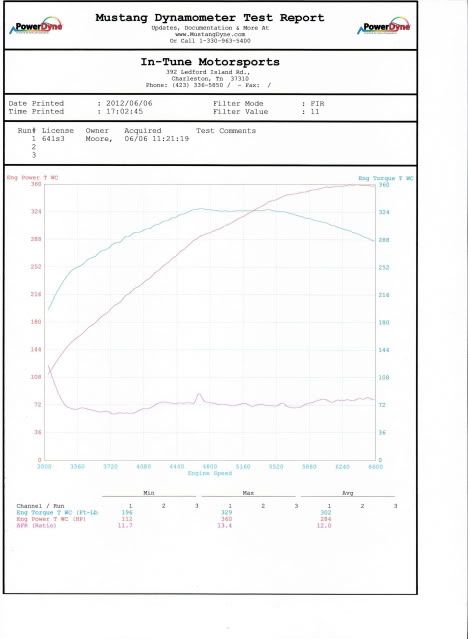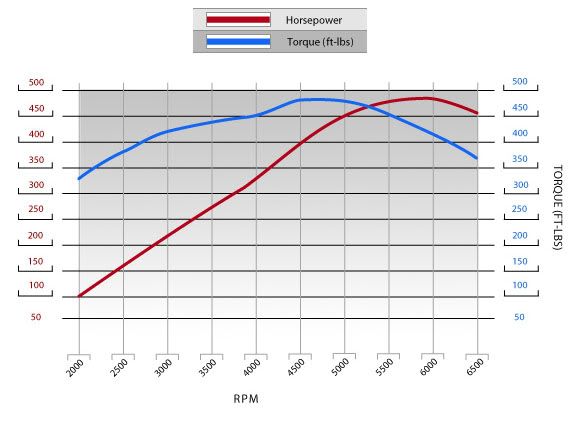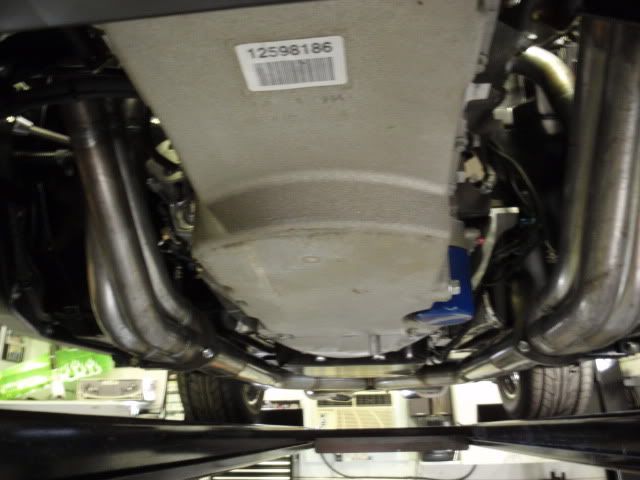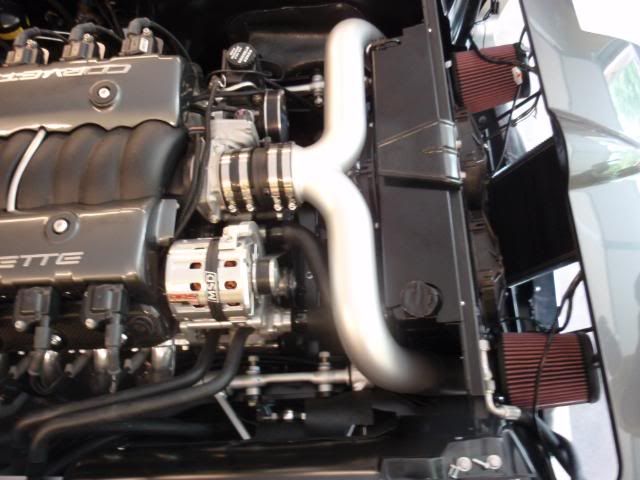LS3 376/480 HO Dyno
#1
Melting Slicks


Thread Starter
I know some here have are looking at the LS 376/480 Hot Cam engine. The lope can be tuned at least for automatic car so it does rock the car. Bucking was never an issue as it just idled around on it's on without touching throttle. Still does that.
If chassis dyno used is spot on then max HP is within 25% drivtrain lost of GM's engine Dyno peak HP. 360 HP Vs 480 HP.
TQ on the other hand is 30% off peak engine dyno TQ. 329 TQ Vs 470.
What puzzles me is peak HP on GM's dyno sheet is at 5800 RPM. Peak HP on my sheet has moved out to 6506 RPM. I would have thought that peak HP like Peak TQ would still occur at same RPM as shown on Engine Dyno Sheet based on cam's design. Like everyone, I would have loved to see higher numbers.
What I see is AFR is rich on low end, may be due to gear run was done in and/or exhaust. Any thoughts?


Transmission is TCI 6X and rear gearing is 3.55. Run was done in 4th gear (3.55 X 1.18 = 4.19 drive ratio. Since car will trap in 4th gear in 1/4 mile, 4th may have been the better gear to tune in anyway) rather than 1:1 5th gear and converter was not locked.
TQ converter is a Circle D dual clutch billet aluminum stalled in 2500 - 2800 range. If your wondering why such a low stall RPM, it's due to the 6X close ratio gearing which provides great RPM retention between shifts compared to 4l65 & 4L80 transmission gearing. Had to change shift point from 6000 RPM to 6600 RPM due to HP's RPM peak change. We data logged a WOT run 1st - 4th on street and the RPM retention between shifts was better than antisipated. Greatest lost was back to 5046 RPM.
TCI 6X (4L80E based)
2.93
2.23 -- 76.10% (high) RPM Retention -- 23.90% RPM DROP
1.57 -- 70.40% (high) RPM Retention -- 29.60% RPM DROP
1.18 -- 75.16% (high) RPM Retention -- 24.84% RPM DROP
1.00 -- 84.745% (high) RPM Retention -- 15.255% RPM DROP
0.75 -- 75.00% (high) RPM Retention -- 25.00% RPM DROP
4l65/70
3.06
1.62 -- 52.94% (high) RPM Retention 47.06% RPM DROP
1.00 -- 61.73% (high) RPM Retention 38.27% RPM DROP
4l80/85
2.48
1.48 -- 59.68% (high) RPM Retention 40.32% RPM DROP
1.00 -- 67.57% (high) RPM Retention 32.43% RPM DROP
Headers 1 3/4 tube, sort of a mid length, with not much of a collector because of need to get ground clearance, it had to be shorten to transition to 3.0" oval pipe at firewall. Muffler are Billy Boat Z06 NPP Fusion for 3.0" for wide open 3.0" exhaust from header back when needed.

Air intake is home made cold air with dual 650 CFM filters feeding dual 3.0" piping stepped to 3 1/2' then to 4.0". MAF sensor used is LS2.

If chassis dyno used is spot on then max HP is within 25% drivtrain lost of GM's engine Dyno peak HP. 360 HP Vs 480 HP.
TQ on the other hand is 30% off peak engine dyno TQ. 329 TQ Vs 470.
What puzzles me is peak HP on GM's dyno sheet is at 5800 RPM. Peak HP on my sheet has moved out to 6506 RPM. I would have thought that peak HP like Peak TQ would still occur at same RPM as shown on Engine Dyno Sheet based on cam's design. Like everyone, I would have loved to see higher numbers.
What I see is AFR is rich on low end, may be due to gear run was done in and/or exhaust. Any thoughts?


Transmission is TCI 6X and rear gearing is 3.55. Run was done in 4th gear (3.55 X 1.18 = 4.19 drive ratio. Since car will trap in 4th gear in 1/4 mile, 4th may have been the better gear to tune in anyway) rather than 1:1 5th gear and converter was not locked.
TQ converter is a Circle D dual clutch billet aluminum stalled in 2500 - 2800 range. If your wondering why such a low stall RPM, it's due to the 6X close ratio gearing which provides great RPM retention between shifts compared to 4l65 & 4L80 transmission gearing. Had to change shift point from 6000 RPM to 6600 RPM due to HP's RPM peak change. We data logged a WOT run 1st - 4th on street and the RPM retention between shifts was better than antisipated. Greatest lost was back to 5046 RPM.
TCI 6X (4L80E based)
2.93
2.23 -- 76.10% (high) RPM Retention -- 23.90% RPM DROP
1.57 -- 70.40% (high) RPM Retention -- 29.60% RPM DROP
1.18 -- 75.16% (high) RPM Retention -- 24.84% RPM DROP
1.00 -- 84.745% (high) RPM Retention -- 15.255% RPM DROP
0.75 -- 75.00% (high) RPM Retention -- 25.00% RPM DROP
4l65/70
3.06
1.62 -- 52.94% (high) RPM Retention 47.06% RPM DROP
1.00 -- 61.73% (high) RPM Retention 38.27% RPM DROP
4l80/85
2.48
1.48 -- 59.68% (high) RPM Retention 40.32% RPM DROP
1.00 -- 67.57% (high) RPM Retention 32.43% RPM DROP
Headers 1 3/4 tube, sort of a mid length, with not much of a collector because of need to get ground clearance, it had to be shorten to transition to 3.0" oval pipe at firewall. Muffler are Billy Boat Z06 NPP Fusion for 3.0" for wide open 3.0" exhaust from header back when needed.

Air intake is home made cold air with dual 650 CFM filters feeding dual 3.0" piping stepped to 3 1/2' then to 4.0". MAF sensor used is LS2.

#2
I pulled the following statement from C6 threads dealing with drive train loss.
''Manual driveline loss for LS3 is 55 to 60 HP, Auto is 65 to 70 HP.''
Your losing power. An actual dyno tune should identify the culprit/culprits. Try removing the air filters, as the problem may be very simple.
''Manual driveline loss for LS3 is 55 to 60 HP, Auto is 65 to 70 HP.''
Your losing power. An actual dyno tune should identify the culprit/culprits. Try removing the air filters, as the problem may be very simple.
#3
Drifting


Jere,
We always want more
There are a ton of variables that can impact the overall numbers and peak RPM's.
The first thing I would question is the tune, the fuel tables, O2 and timing readings need to be compared. That fat fuel curve you mention on the low end will hurt the response and it is not overcoming the extra fuel until you get higher in RPM causing the peak power to be higher.
Overall, the HP power curve does not look too bad...although a little low, the TRQ is what concerns me. While it does not show the typical TRQ drop at the initial punch, it looks very lazy on the low end...even for a cammed engine (all that fuel is not helping). Is this a stock tune or has it been worked with?? Have a good tuner work with it, you will be amazed!! (Mike Norris Motorsports is not too far away from you, he handles DSE's cars and can get that thing cooking for ya!!)
IT's ALL ABOUT THE TUNE!!
R/
Jeff
We always want more

There are a ton of variables that can impact the overall numbers and peak RPM's.
The first thing I would question is the tune, the fuel tables, O2 and timing readings need to be compared. That fat fuel curve you mention on the low end will hurt the response and it is not overcoming the extra fuel until you get higher in RPM causing the peak power to be higher.
Overall, the HP power curve does not look too bad...although a little low, the TRQ is what concerns me. While it does not show the typical TRQ drop at the initial punch, it looks very lazy on the low end...even for a cammed engine (all that fuel is not helping). Is this a stock tune or has it been worked with?? Have a good tuner work with it, you will be amazed!! (Mike Norris Motorsports is not too far away from you, he handles DSE's cars and can get that thing cooking for ya!!)

IT's ALL ABOUT THE TUNE!!
R/
Jeff
#4
Le Mans Master


Jere,
We always want more
There are a ton of variables that can impact the overall numbers and peak RPM's.
The first thing I would question is the tune, the fuel tables, O2 and timing readings need to be compared. That fat fuel curve you mention on the low end will hurt the response and it is not overcoming the extra fuel until you get higher in RPM causing the peak power to be higher.
Overall, the HP power curve does not look too bad...although a little low, the TRQ is what concerns me. While it does not show the typical TRQ drop at the initial punch, it looks very lazy on the low end...even for a cammed engine (all that fuel is not helping). Is this a stock tune or has it been worked with?? Have a good tuner work with it, you will be amazed!! (Mike Norris Motorsports is not too far away from you, he handles DSE's cars and can get that thing cooking for ya!!)
IT's ALL ABOUT THE TUNE!!
R/
Jeff
We always want more

There are a ton of variables that can impact the overall numbers and peak RPM's.
The first thing I would question is the tune, the fuel tables, O2 and timing readings need to be compared. That fat fuel curve you mention on the low end will hurt the response and it is not overcoming the extra fuel until you get higher in RPM causing the peak power to be higher.
Overall, the HP power curve does not look too bad...although a little low, the TRQ is what concerns me. While it does not show the typical TRQ drop at the initial punch, it looks very lazy on the low end...even for a cammed engine (all that fuel is not helping). Is this a stock tune or has it been worked with?? Have a good tuner work with it, you will be amazed!! (Mike Norris Motorsports is not too far away from you, he handles DSE's cars and can get that thing cooking for ya!!)

IT's ALL ABOUT THE TUNE!!
R/
Jeff
 .....pm jdk971......he had the exact problem with the same combo with a 5 speed and his tuner went from a "cadillac" module to something else and fixed the over rich issue....im sure he will share his info and the car is a rocket!.....good stuff....
.....pm jdk971......he had the exact problem with the same combo with a 5 speed and his tuner went from a "cadillac" module to something else and fixed the over rich issue....im sure he will share his info and the car is a rocket!.....good stuff....

#5
Race Director


Here is some AFR chassis dyno comparisons (through full exhaust, in street rim) vs output. This is on an old school small Block of about 427 CI.
You can see some minor improvements from changing the AFR in it optimum range. The smoothed out AFR line is what gave the best results, the smoothing is computer averaged to get rid of the jaggedness.

Doug
You can see some minor improvements from changing the AFR in it optimum range. The smoothed out AFR line is what gave the best results, the smoothing is computer averaged to get rid of the jaggedness.

Doug
#6
Melting Slicks


Thread Starter
I pulled the following statement from C6 threads dealing with drive train loss.
''Manual driveline loss for LS3 is 55 to 60 HP, Auto is 65 to 70 HP.''
Your losing power. An actual dyno tune should identify the culprit/culprits. Try removing the air filters, as the problem may be very simple.
''Manual driveline loss for LS3 is 55 to 60 HP, Auto is 65 to 70 HP.''
Your losing power. An actual dyno tune should identify the culprit/culprits. Try removing the air filters, as the problem may be very simple.
Filter wise the problem is probably not their flow, 650 CFM each with 3.0" piping. It's not feeding that 6.0" of air into a 4.0 in tube that matches size of throttle body, but having to step up form 3.0" to 3.50", then 4.0" at the LS2 MAF sensor I'm using and it still has screen, as it hasn't been knocked out like most LS2 owners do to increase Air Flow.
Reason 'm not using a LS3/7/9 MAF is they work best inserted in 4.0" straight section of pipe prior to throttle body. I don't have that kind of room. If Jeff had given me the dimensions for his hood hinges, I could have lifted hood out of opening and ran a cold air setup like his....LOL I've away known I might have a problem with supplying air engine needs with my intake setup. I do plan to try and get the two 3.0" pipes feeding into 4.0" pipe later on.
#7
Melting Slicks


Thread Starter
Jere,
We always want more
There are a ton of variables that can impact the overall numbers and peak RPM's.
The first thing I would question is the tune, the fuel tables, O2 and timing readings need to be compared. That fat fuel curve you mention on the low end will hurt the response and it is not overcoming the extra fuel until you get higher in RPM causing the peak power to be higher.
Overall, the HP power curve does not look too bad...although a little low, the TRQ is what concerns me. While it does not show the typical TRQ drop at the initial punch, it looks very lazy on the low end...even for a cammed engine (all that fuel is not helping). Is this a stock tune or has it been worked with?? Have a good tuner work with it, you will be amazed!! (Mike Norris Motorsports is not too far away from you, he handles DSE's cars and can get that thing cooking for ya!!)
IT's ALL ABOUT THE TUNE!!
R/
Jeff
We always want more

There are a ton of variables that can impact the overall numbers and peak RPM's.
The first thing I would question is the tune, the fuel tables, O2 and timing readings need to be compared. That fat fuel curve you mention on the low end will hurt the response and it is not overcoming the extra fuel until you get higher in RPM causing the peak power to be higher.
Overall, the HP power curve does not look too bad...although a little low, the TRQ is what concerns me. While it does not show the typical TRQ drop at the initial punch, it looks very lazy on the low end...even for a cammed engine (all that fuel is not helping). Is this a stock tune or has it been worked with?? Have a good tuner work with it, you will be amazed!! (Mike Norris Motorsports is not too far away from you, he handles DSE's cars and can get that thing cooking for ya!!)

IT's ALL ABOUT THE TUNE!!
R/
Jeff
I agree with you. No matter how I have restricted power engine can make, if the TUNE for my bad combination is off, it only makes things worst.

jdk971 (jim) just PM me and pointed me to his 480 HO dyno. His dyno sheet printout has AFR print out that matches up with HP & TQ numbers in 100 RPM increments. His engine makes it Peak HP & TQ numbers about spot on with GM engine dyno 480 HO sheet. Looking at his AFR tells me why my engine looks like it making power to 6500 RPM, it's not. It's that way because engine AFR is too Rich from 3000 RPM to 6000 RPM, then it leans out causing HP and TQ to increase above where HP should have peaked due to engine being to rich in peak HP RPM range. 6600 is were it HP would be as it fall off peak from it's real peak RPM...

Jim's 480 AFR is richer across the RPM range than my engine is. It's in the 9.0-11.0 range from 2500 to 6500 RPM. Mine is definitly too rich from 2500-6000, then from 6200-6600 AFR is probably close to being about right.



Jim an I both need to find a tuner. There is a lot of power left on the table for both our engines..

Last edited by Poorhousenext; 06-08-2012 at 12:54 PM.
#8
Burning Brakes


Member Since: Jul 2009
Location: Sarasota,FL & NW Indiana
Posts: 772
Likes: 0
Received 7 Likes
on
4 Posts

Jere,
I always wondered about the sharp turn with your intake, just before the MAF. Perhaps next time on the dyno, swap out for a straight pipe test.
Mike Norris is very good, but he is in Indy. Worked on my car 3 times. Since you are in Chattanooga. IMHO talk to Ron @ Vengeance (short drive for you )
Vengeance racing
Phone: 678-513-7105
241 Castleberry Industrial Drive, Suite B
Cumming, GA 30040
R/ Jim
I always wondered about the sharp turn with your intake, just before the MAF. Perhaps next time on the dyno, swap out for a straight pipe test.
Mike Norris is very good, but he is in Indy. Worked on my car 3 times. Since you are in Chattanooga. IMHO talk to Ron @ Vengeance (short drive for you )
Vengeance racing
Phone: 678-513-7105
241 Castleberry Industrial Drive, Suite B
Cumming, GA 30040
R/ Jim
Last edited by jjtoma; 06-09-2012 at 03:13 PM.
#9
Good luck with the tune. Your nice looking intake might cost a few hp, but not many. LS engines are great but they do have a downside. The downside is the the requirement for dyno tuning. You cant tune an LS motor without putting it on a dyno. At $500-$1000 a pop, you can certainly see why mechanics vote for LS motors, lol. Good repeat business!





